
Petone, a large suburb of Lower Hutt, Wellington, stands at the southern end of the Hutt Valley, on the northern shore of Wellington Harbour. The Māori name Pito-one means "end of the sand beach".
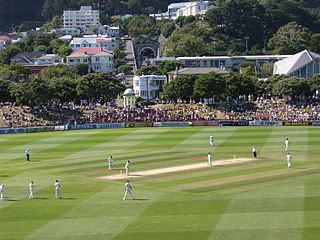
The Basin Reserve, also known as the Cello Basin Reserve for sponsorship reasons, and commonly referred to as the Basin, is a cricket ground in Wellington, New Zealand. It is used for Test matches, and is the main home ground of the Wellington Firebirds first-class team. The Basin Reserve is the only cricket ground to have listed status with Heritage New Zealand, in recognition of being the oldest first-class cricket ground in the country. Historically, the ground has also been used for events other than cricket, such as association football matches, concerts and cultural events.

Wellington East Girls' College is a state single-sex girls' secondary school which sits directly above Mount Victoria Tunnel, Wellington, New Zealand. Serving Years 9 to 13, the school currently has 1072 students.
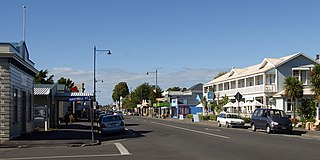
Greytown, population 2,202, is a rural town in the centre of the Wairarapa region of New Zealand, in the lower North Island. It is 80 km north-east of Wellington and 25 kilometres southwest of Masterton, on State Highway 2. It was awarded the title of New Zealand's Most Beautiful Small Town 2017.

The Museum of New Zealand Te Papa Tongarewa is New Zealand's national museum and is located in Wellington. Usually known as Te Papa, it opened in 1998 after the merging of the National Museum of New Zealand and the National Art Gallery. An average of more than 1.5 million people visit every year, making it the 26th-most-visited art gallery in the world. Te Papa operates under a bicultural philosophy, and emphasises the living stories behind its cultural treasures.

The Grand Chateau, also known as the Chateau Tongariro, is a hotel and resort complex located close to Whakapapa skifield on the slopes of Mount Ruapehu, within the boundaries of Tongariro National Park, New Zealand's oldest national park. It is also close to the volcanic peaks of Mount Tongariro and Mount Ngauruhoe. The building was completed in 1929 and, despite extensive refurbishment, still retains much of the style of the pre-Depression era. It is listed by Heritage New Zealand as a Category 1 historic place. The Chateau Tongariro Hotel closed permanently on 5 February 2023, largely because the building has significant seismic risks.

Thorndon is a historic inner suburb of Wellington, the capital city of New Zealand. Because the suburb is relatively level compared to the hilly terrain elsewhere in Wellington it contained Wellington's elite residential area until its best was destroyed in the 1960s by a new motorway and the erection of tall office buildings on the sites of its Molesworth Street retail and service businesses.

The Beehive is the common name for the Executive Wing of New Zealand Parliament Buildings, located at the corner of Molesworth Street and Lambton Quay, Wellington. It is so-called because its shape is reminiscent of that of a traditional woven form of beehive known as a skep. It is registered as a Category I heritage building by Heritage New Zealand.

New Zealand Parliament Buildings house the New Zealand Parliament and are on a 45,000 square metre site at the northern end of Lambton Quay, Wellington. They consist of the Edwardian neoclassical-style Parliament House (1922); the Parliamentary Library (1899); the executive wing, called "The Beehive" (1977); and Bowen House, in use since 1991. Whilst most of the individual buildings are outstanding for different reasons, the overall setting that has been achieved "has little aesthetic or architectural coherence".

Oriental Bay is a bay and suburb of Wellington, the capital city of New Zealand. Noted for being both a popular beach and a luxurious centre of affluence in the city, it is located close to the Central Business District on Wellington Harbour.

Brooklyn is a suburb of Wellington, the capital city of New Zealand, under the governance of Wellington City Council. It lies 3 km south of Wellington's central business district on the eastern slopes of the hills above Happy Valley. It is located to the south of Aro Valley and Highbury, west of Mount Cook, north of Vogeltown, Mornington and Ōwhiro Bay and east of Kowhai Park, Panorama Heights, Mitcheltown and Karori.
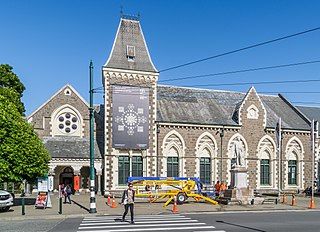
The Canterbury Museum is a museum located in the central city of Christchurch, New Zealand, in the city's Cultural Precinct. The museum was established in 1867 with Julius von Haast – whose collection formed its core – as its first director. The building is registered as a "Historic Place – Category I" by Heritage New Zealand.

Cuba Street is a prominent city street in Wellington, New Zealand. Among the best known and most popular streets in the city, the Cuba precinct has been labelled Wellington's cultural centre, and is known for its high-per-capita arts scene the world over.
Architecture of New Zealand is the built environment of regions, cities and towns of New Zealand.
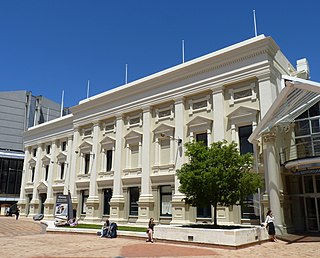
The Wellington Town Hall is a concert hall and part of the municipal complex in Wellington, New Zealand, which opened in December 1904. It is closed to the public since the 2013 Seddon earthquake for extensive strengthening work, and projected to reopen in January 2025.

Kirkcaldie & Stains was a mid-sized department store in Wellington, New Zealand. It was established in 1863 by John Kirkcaldie and Robert Stains with a capital of £700. The first store was opened on Lambton Quay. In 1868 Kirkcaldie & Stains moved to their final location at the corner of Lambton Quay and Brandon Street, expanding several times. There was a branch in Napier from 1897 until 1917, and a branch on Cuba Street, Wellington for seven years (1871–76). French luxury skincare brand Sisley was exclusive to the store in New Zealand.

The Former Australian Temperance & General Mutual Life Assurance Society Limited Head Office is a historic building on Lambton Quay, Wellington, New Zealand.
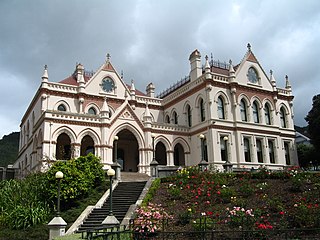
The New Zealand Parliamentary Library, known until 1985 as the General Assembly Library, is the library and information resource of the New Zealand Parliament. The present building that houses the library was completed in 1899; it survived a fire that destroyed the rest of the General Assembly building in 1907.

Evans Bay is a large bay at the southern end of Wellington Harbour, New Zealand. Located between the Miramar Peninsula and Hataitai, it was the site of New Zealand's first patent slip and served as Wellington's international flying-boat terminal from 1938 until 1956. It is named after George Samuel Evans, an early Wellington settler.

Petone Settlers Museum is a local history museum located in the Wellington Provincial Centennial Memorial, a historic building in Petone, Lower Hutt, New Zealand. The building was originally constructed to mark the Wellington province's centennial commemorations; the museum opened in the building in 1977. The building was extensively refurbished in 2016.





















